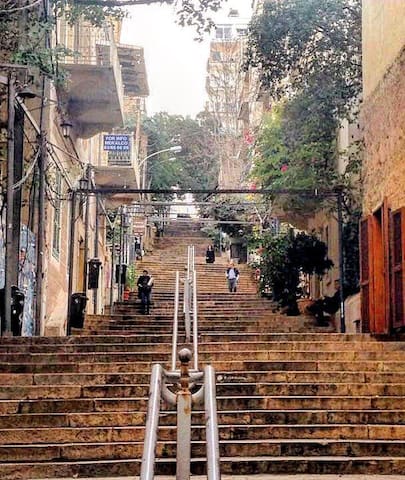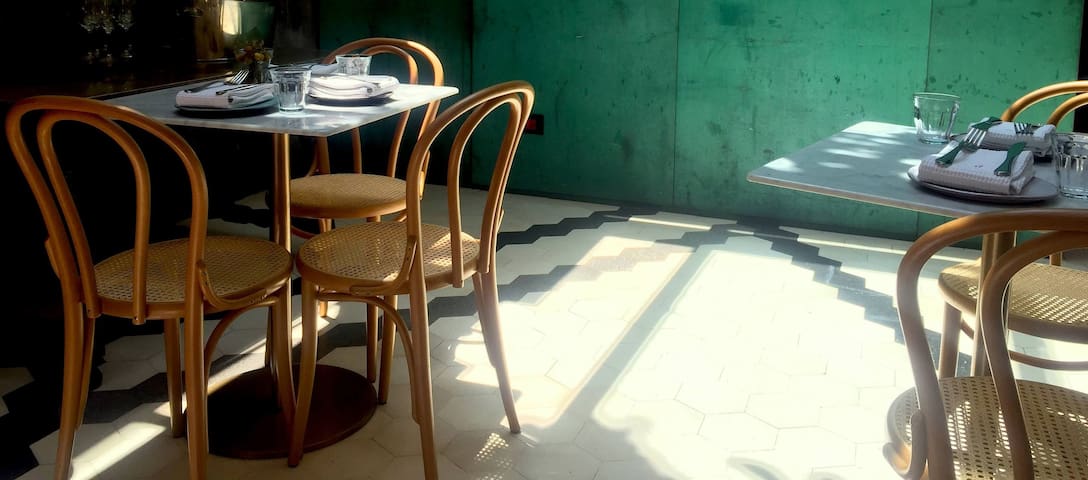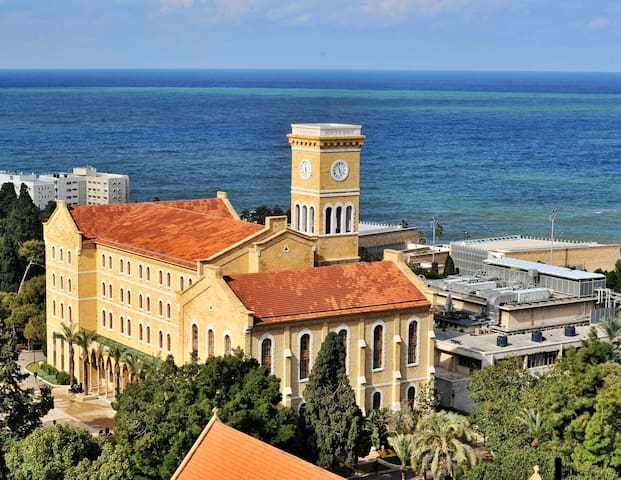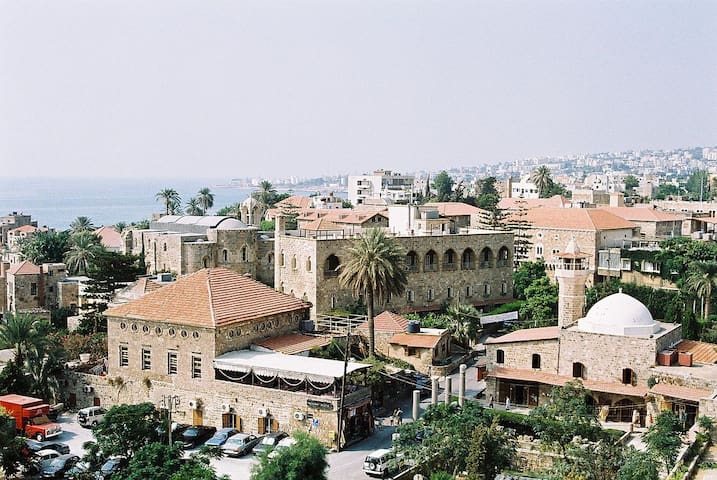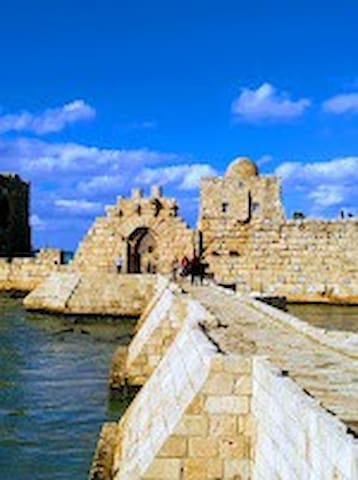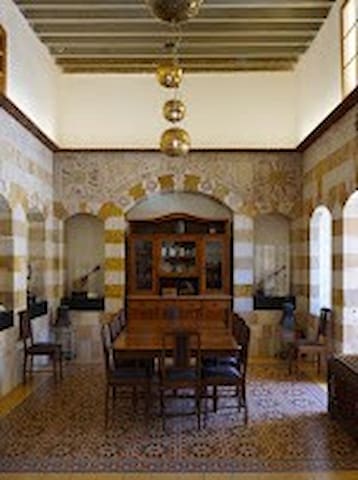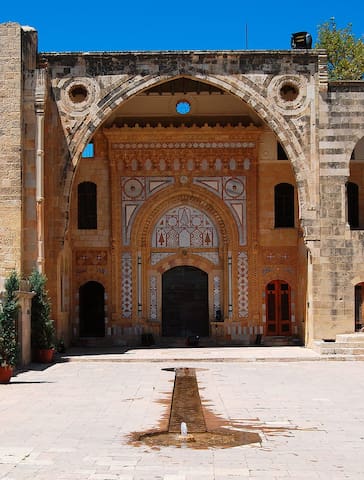Food scene
Good restaurant good food
Beirut’s traditional Gemmayze quarter is witnessing a hospitality renaissance. A quick walk (or a slow drive) down the newly-paved Rue Gouraud and its less populated cousin, the lower and parallel Rue Pasteur, reveals a changing landscape of restaurants and coffee shops, design and art spaces, modern boutiques, and offices—almost all of them new faces, save for a handful of Beirut institutions. Named after the lush gemmayze (sycamore) trees that once flourished there, the charming streets are lined with the traditional, low-rise architecture that now serves these new establishments.
36 lokal ang nagrerekomenda
Gemmayzeh
Beirut’s traditional Gemmayze quarter is witnessing a hospitality renaissance. A quick walk (or a slow drive) down the newly-paved Rue Gouraud and its less populated cousin, the lower and parallel Rue Pasteur, reveals a changing landscape of restaurants and coffee shops, design and art spaces, modern boutiques, and offices—almost all of them new faces, save for a handful of Beirut institutions. Named after the lush gemmayze (sycamore) trees that once flourished there, the charming streets are lined with the traditional, low-rise architecture that now serves these new establishments.
Party in a former detention center
In Western cultural consciousness, the name ‘Beirut’ tends to evoke either war or parties. ‘Why not do both in one space?’ replies Beirut, and here we have it: B018, the legendary club in Karantina. The area’s name stems from the quarantine that stood here in the days of the French protectorate; it later became the site of a camp for thousands of Palestinian, Kurdish, and South Lebanese refugees, who were all massacred or expelled by a Phalangist militia in 1976. Today, and not without controversy, it is home to this sprawling underground club. DJ sets run into the early hours of the morning, when dawn signals the time to draw back the roof and reveal the stars and city lights. It’s explosive.
B 018, also pronounced in French B Dix-Huit, is a nightclub that was established in 1994 in Beirut, Lebanon.
Today, by staying true to its claim, "A Sound Ritual", B 018 offers an array of nights. From live bands to 80s night during the week and international and local house DJs on the weekends, the club feeds everything heart and ears desire.
25 lokal ang nagrerekomenda
B 018
Party in a former detention center
In Western cultural consciousness, the name ‘Beirut’ tends to evoke either war or parties. ‘Why not do both in one space?’ replies Beirut, and here we have it: B018, the legendary club in Karantina. The area’s name stems from the quarantine that stood here in the days of the French protectorate; it later became the site of a camp for thousands of Palestinian, Kurdish, and South Lebanese refugees, who were all massacred or expelled by a Phalangist militia in 1976. Today, and not without controversy, it is home to this sprawling underground club. DJ sets run into the early hours of the morning, when dawn signals the time to draw back the roof and reveal the stars and city lights. It’s explosive.
B 018, also pronounced in French B Dix-Huit, is a nightclub that was established in 1994 in Beirut, Lebanon.
Today, by staying true to its claim, "A Sound Ritual", B 018 offers an array of nights. From live bands to 80s night during the week and international and local house DJs on the weekends, the club feeds everything heart and ears desire.
Good restaurant walking distance located behind the apartment in mar Micheal
25 lokal ang nagrerekomenda
BARON
Good restaurant walking distance located behind the apartment in mar Micheal
Sightseeing
Beirut Central District is the financial center of Lebanon, as well as the historical and geographical center of its capital. Severely damaged during the 15 year long civil war (1975-1990), it’s reconstruction constitutes one of the most ambitious urban redevelopment projects anywhere in the world. Now nearing its completion and successfully enjoying a vibrant second lease of life, here are 10 sights and activities to pursue in unique juxtapositions of old and new Beirut.
37 lokal ang nagrerekomenda
Downtown Beirut
Beirut Central District is the financial center of Lebanon, as well as the historical and geographical center of its capital. Severely damaged during the 15 year long civil war (1975-1990), it’s reconstruction constitutes one of the most ambitious urban redevelopment projects anywhere in the world. Now nearing its completion and successfully enjoying a vibrant second lease of life, here are 10 sights and activities to pursue in unique juxtapositions of old and new Beirut.
The American University of Beirut (AUB) is a private, non sectarian, and independent university in Beirut, Lebanon. It is one of the most prestigious universities in the Middle East, securing the top spot in the Arab region in the 2018 World University Rankings.
On January 23, 1862, W. M. Thomson proposed to a meeting of the American Board of Commissioners for Foreign Missions that a college of higher learning, that would include medical training, should be established in Beirut with Dr. Daniel Bliss as its president. On April 24, 1863, while Bliss was raising money for the new college in the United States and England, the State of New York granted a charter for the Syrian Protestant College. The college,
which was renamed the American University of Beirut in 1920, opened with a class of 16 students on December 3, 1866. Bliss served as its first president, from 1866 until 1902. In the beginning Arabic was used as the language of instruction because it was the common language of the ethnic groups of the region, and prospective students needed to be fluent in Ottoman Turkish or in French as well as in English. In 1887 the language of instruction became English
17 lokal ang nagrerekomenda
American University of Beirut
The American University of Beirut (AUB) is a private, non sectarian, and independent university in Beirut, Lebanon. It is one of the most prestigious universities in the Middle East, securing the top spot in the Arab region in the 2018 World University Rankings.
On January 23, 1862, W. M. Thomson proposed to a meeting of the American Board of Commissioners for Foreign Missions that a college of higher learning, that would include medical training, should be established in Beirut with Dr. Daniel Bliss as its president. On April 24, 1863, while Bliss was raising money for the new college in the United States and England, the State of New York granted a charter for the Syrian Protestant College. The college,
which was renamed the American University of Beirut in 1920, opened with a class of 16 students on December 3, 1866. Bliss served as its first president, from 1866 until 1902. In the beginning Arabic was used as the language of instruction because it was the common language of the ethnic groups of the region, and prospective students needed to be fluent in Ottoman Turkish or in French as well as in English. In 1887 the language of instruction became English
4- The Roman temple at Baalbek (which the Greeks called Heliopolis, or ‘City of the Sun’) was one of the most celebrated sanctuaries of the ancient world, and remains the poster child of the Lebanese tourism board. A UNESCO World Heritage Site, the ruins are a sight to behold: for sheer grandeur, nothing in the country beats the vista of the Imperial Roman columns soaring over the skyline of the Bekaa Valley. In the summer, the Baalbeck International Festival brings the monuments to life with an array of plays and concerts.
24 lokal ang nagrerekomenda
Mga Romanong Kalansay sa Baalbek
4- The Roman temple at Baalbek (which the Greeks called Heliopolis, or ‘City of the Sun’) was one of the most celebrated sanctuaries of the ancient world, and remains the poster child of the Lebanese tourism board. A UNESCO World Heritage Site, the ruins are a sight to behold: for sheer grandeur, nothing in the country beats the vista of the Imperial Roman columns soaring over the skyline of the Bekaa Valley. In the summer, the Baalbeck International Festival brings the monuments to life with an array of plays and concerts.
Byblos, known locally as Jbeil is the largest city in the Mount Lebanon Governorate of Lebanon. It is believed to have been first occupied between 8800 and 7000 BC and continuously inhabited since 5000 BC, making it one of the oldest continuously inhabited cities in the world. It is a UNESCO World Heritage Site.
83 lokal ang nagrerekomenda
Byblos
Byblos, known locally as Jbeil is the largest city in the Mount Lebanon Governorate of Lebanon. It is believed to have been first occupied between 8800 and 7000 BC and continuously inhabited since 5000 BC, making it one of the oldest continuously inhabited cities in the world. It is a UNESCO World Heritage Site.
Tyre’s Hippodrome is a sprawling spectacle of ancient Roman grandeur. The Hippodrome once held up to 40,000 people, who sat along the stadium stands to cheer on chariot races and possibly even gladiator games. The ruins are remarkably well preserved and you can climb up the stadium seating and wander through ancient archways and a Roman street. What’s most impressive about the Hippodrome is not its size in height but rather how large the complex is. The Hippodrome ruins are the size of numerous football fields, making exploration of the site an adventure in itself.
22 lokal ang nagrerekomenda
Tyre
Tyre’s Hippodrome is a sprawling spectacle of ancient Roman grandeur. The Hippodrome once held up to 40,000 people, who sat along the stadium stands to cheer on chariot races and possibly even gladiator games. The ruins are remarkably well preserved and you can climb up the stadium seating and wander through ancient archways and a Roman street. What’s most impressive about the Hippodrome is not its size in height but rather how large the complex is. The Hippodrome ruins are the size of numerous football fields, making exploration of the site an adventure in itself.
Jeita Grotto was chosen as an official finalist representing Lebanon and selected as one of the
14 worldwide landmarks new7wonders of nature competition
58 lokal ang nagrerekomenda
Jeita Grotto
شارع كسروانJeita Grotto was chosen as an official finalist representing Lebanon and selected as one of the
14 worldwide landmarks new7wonders of nature competition
Sidon's Sea Castle was built by the crusaders in the thirteenth century as a fortress of the holy land. It is one of the most prominent historical sites in the port city of Sidon, Lebanon.
16 lokal ang nagrerekomenda
Sidon Sea Castle
Sidon's Sea Castle was built by the crusaders in the thirteenth century as a fortress of the holy land. It is one of the most prominent historical sites in the port city of Sidon, Lebanon.
The Sidon Soap Museum is a museum in coastal Lebanese city Sidon. It traces the history of soap making in the region, its development and manufacturing techniques. Visitors can see a demonstration of how traditional olive oil soaps are made and learn about the history of the "hammam" traditions
13 lokal ang nagrerekomenda
Soap Museum
The Sidon Soap Museum is a museum in coastal Lebanese city Sidon. It traces the history of soap making in the region, its development and manufacturing techniques. Visitors can see a demonstration of how traditional olive oil soaps are made and learn about the history of the "hammam" traditions
Saida’s historic Debbane Palace is one of the few remaining examples of Ottoman architecture in the city. Raphael Debbane transformed it from a family home into a museum and opened it to the public.
Debbane Palace is an 18th century building in Saida, built by Ali Hammoud in 1721. The atmospheric space features typical diwans (Oriental style living rooms), a liwan (a long narrow-fronted hall), several rooms and an open-air courtyard, with the characteristic features of the Ottoman period – brown and white stripes of stone and intricate mosaic tiles making up the interior. Despite its location on the bustling streets of Saida, the house is a peaceful escape.
6 lokal ang nagrerekomenda
Dabane Palace / Debbane Palace Museum / Musee Historique de Saida
Saida’s historic Debbane Palace is one of the few remaining examples of Ottoman architecture in the city. Raphael Debbane transformed it from a family home into a museum and opened it to the public.
Debbane Palace is an 18th century building in Saida, built by Ali Hammoud in 1721. The atmospheric space features typical diwans (Oriental style living rooms), a liwan (a long narrow-fronted hall), several rooms and an open-air courtyard, with the characteristic features of the Ottoman period – brown and white stripes of stone and intricate mosaic tiles making up the interior. Despite its location on the bustling streets of Saida, the house is a peaceful escape.
Our Lady of Awaiting, also known as Our Lady of Mantara, is a Melkite Greek Catholic Marian shrine in Maghdouché, Lebanon, discovered on 8 September 1721 by a young shepherd
Located in South Lebanon, Maghdouche is a town with a beautiful story to tell. Recognized as an important destination for pilgrims, it is also a place where agricultural traditions remain strong and where visitors can enjoy a snapshot of true village life.
The town is located 50km south of Beirut and eight kilometers southeast of Saida, making it a great destination for those looking to do some sightseeing
Maghdoucheh
Our Lady of Awaiting, also known as Our Lady of Mantara, is a Melkite Greek Catholic Marian shrine in Maghdouché, Lebanon, discovered on 8 September 1721 by a young shepherd
Located in South Lebanon, Maghdouche is a town with a beautiful story to tell. Recognized as an important destination for pilgrims, it is also a place where agricultural traditions remain strong and where visitors can enjoy a snapshot of true village life.
The town is located 50km south of Beirut and eight kilometers southeast of Saida, making it a great destination for those looking to do some sightseeing
Beit ed-Dine, also known as Btaddine is a small town and the administrative capital of the Chouf District in the Mount Lebanon Governorate in Lebanon. The town is located 45 kilometers southeast of Beirut, and near the town of Deir el-Qamar from which it is separated by a steep valley.
Emir Bashir II of the Shihab dynasty, who later became the ruler of the Mount Lebanon Emirate, built the palace between 1788 and 1818 at the site of the Druze hermitage. After 1840, the palace was used by the Ottomans as a government building. During the French Mandate it served as a local administrative office.
In 1943, the palace was declared the official president's summer residence. During the Lebanese Civil War it was heavily damaged. Parts of the palace are today open to the public while the rest is still the president's summer residence.
13 lokal ang nagrerekomenda
Beit ed-Dine
Beit ed-Dine, also known as Btaddine is a small town and the administrative capital of the Chouf District in the Mount Lebanon Governorate in Lebanon. The town is located 45 kilometers southeast of Beirut, and near the town of Deir el-Qamar from which it is separated by a steep valley.
Emir Bashir II of the Shihab dynasty, who later became the ruler of the Mount Lebanon Emirate, built the palace between 1788 and 1818 at the site of the Druze hermitage. After 1840, the palace was used by the Ottomans as a government building. During the French Mandate it served as a local administrative office.
In 1943, the palace was declared the official president's summer residence. During the Lebanese Civil War it was heavily damaged. Parts of the palace are today open to the public while the rest is still the president's summer residence.
Deir al-Qamar, meaning "Monastery of the Moon" is a village south-east of Beirut in south-central Lebanon. It is located five kilometres outside of Beiteddine in the Chouf District of the Mount Lebanon Governorate at 800 m of average altitude.
15 lokal ang nagrerekomenda
Deir El Qamar
Deir al-Qamar, meaning "Monastery of the Moon" is a village south-east of Beirut in south-central Lebanon. It is located five kilometres outside of Beiteddine in the Chouf District of the Mount Lebanon Governorate at 800 m of average altitude.

